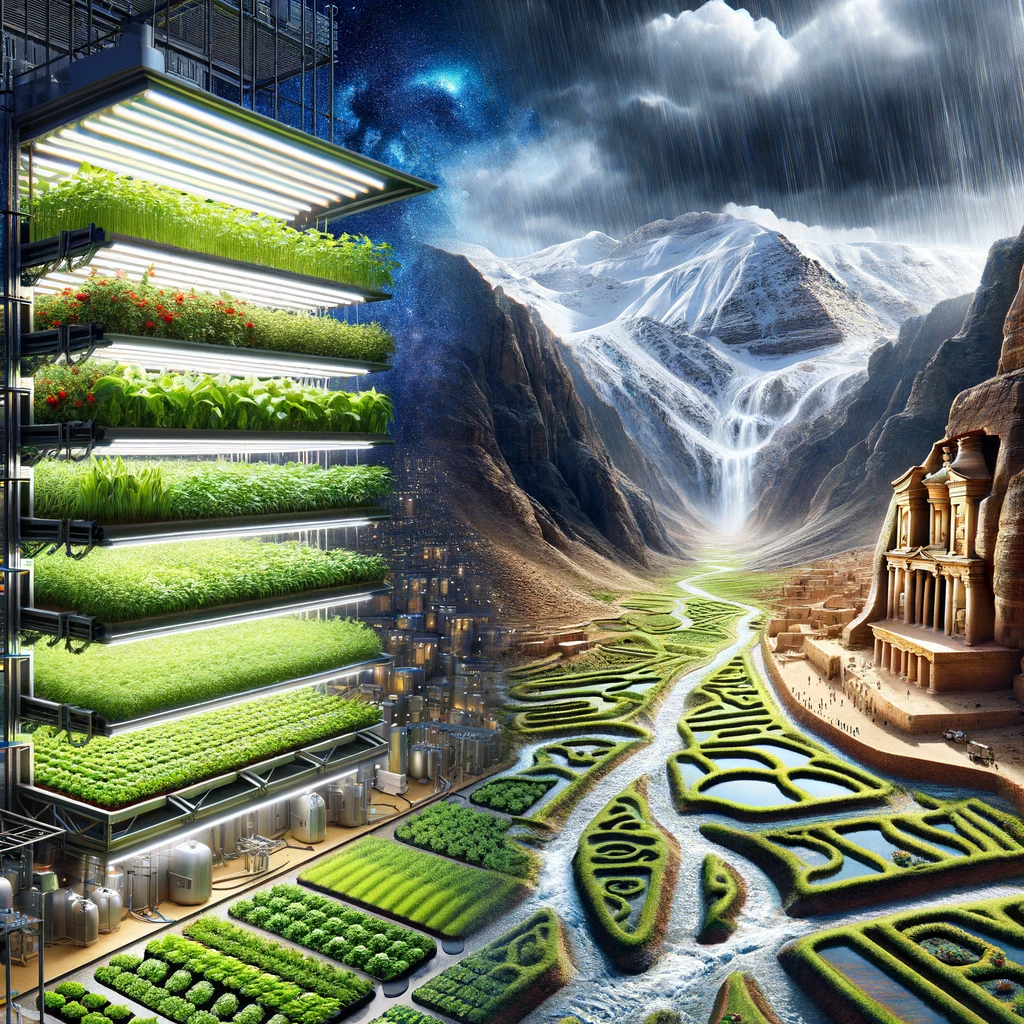In the archives of human innovation, ancient civilizations such as the Aztecs with their Chinampas and the Nabataeans of the city of Petra stand as monumental testaments to our ancestors’ ingenuity in harnessing and manipulating natural resources. These ancient systems were not merely cultural symbols but also early examples of sophisticated environmental engineering and sustainable resource management. Today, as we confront the complexities of the 21st century, indoor vertical farming emerges as the modern embodiment of these ancient principles, integrating the benefits of natural resource availability to push agricultural technology and efficiency to new heights.
**Bridging Ancient Wisdom with Modern Technological and Natural Advantages**
*Historical Significance:*
The Aztecs’ Chinampas, an ingenious method of creating floating gardens, exemplified resourcefulness and sustainability. These ‘floating islands’ maximized agricultural output in limited spaces and created a remarkably productive form of early hydroponics. The Nabataeans, too, showcased profound mastery of water engineering in the desert city of Petra, capturing every drop of rainwater from the mountains for city gardens. These methods of utilizing available resources laid the groundwork for sustainable agricultural practices.
*Current Scenario:*
Modern vertical farming represents a significant advancement in agricultural technology, embodying a “Third Green Revolution.” Today, we have the added advantage of abundant natural resources like sunlight and low-cost energy from renewables, which ancient civilizations could only dream of. Technologies to harness off-take energy from landfills (methane) and natural cooling methods in cooler climates provide additional sustainable energy and temperature control options. Coupled with access to a larger worker pool in some areas, these resources offer unprecedented opportunities for efficient, sustainable, and high-yield agricultural systems.
**Obtaining an Advantage – Lowering Costs with Advanced, Used Horticultural Equipment:**
While the advancements in technology have paved the way for more efficient and productive farming methods, the cost of new equipment and technology can be a significant barrier to entry for many aspiring and existing farmers. However, a sustainable and cost-effective solution is emerging in the form of advanced, used horticultural equipment for greenhouses and indoor vertical farms.
By opting for pre-owned equipment, farmers can significantly reduce their initial investment while still benefiting from the technological advancements of recent years. This approach not only makes the technology more accessible but also contributes to a circular economy by extending the life of equipment and reducing waste.
*Economic Viability:*
The use of advanced, used equipment can drastically lower the cost of setting up and operating indoor farms. This reduction in capital expenditure allows farmers to experiment with innovative techniques, diversify their crops, and improve their yield without the financial burden of new equipment.
*Technological Edge:*
Second-hand equipment doesn’t mean outdated technology. Many facilities upgrade their systems to stay competitive, meaning lightly used, high-tech equipment is often available at a fraction of the cost. This provides an opportunity for smaller or start-up operations to implement advanced systems like automated climate control, efficient LED lighting, and hydroponic or aeroponic systems.
*Environmental Stewardship:*
Choosing used equipment aligns with the environmental ethos of sustainable agriculture. It reduces the demand for new manufacturing, lowers the carbon footprint associated with production, and minimizes waste. It’s a step that resonates with the sustainable practices of the Aztecs and their efficient use of resources in creating the Chinampas.
**Conclusion**
As we continue to refine and enhance our agricultural systems, the integration of historical insights with advanced technology and natural resources guides us towards a more food-secure and environmentally-responsible world. The addition of cost-effective, used horticultural equipment options presents an exciting opportunity for more individuals and communities to participate in this agricultural evolution, continuing the legacy of innovation and sustainability that has been a hallmark of human ingenuity through the ages, from the ancient Aztecs to modern day farmers.

